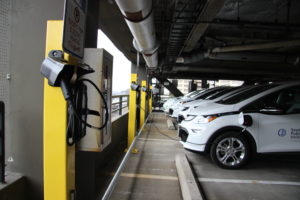
This guest post is from Andrea Pratt, Seattle’s Green Fleet Program Manager. It is thanks to her hard work, and the work of Seattle’s Finance & Administrative Services department that our city continues to lead the way on green fleet management. – J.A.D.
Green vehicles are nothing new to the Emerald City. Since the late 1990s, the municipal fleet has been front and center to the City’s climate and environmental goals. Leading by example through our own operations, the City was the first in the nation to introduce hybrids, low carbon biodiesel and electric vehicles into a municipal fleet and now the first to install the largest number of charging stations in one location.
The recently completed Seattle Municipal Tower Fleet EV project added 156 “level 2” charging stations, increasing the total in this City-owned parking garage to 188, which is impressive but also pragmatic. This investment will allow us to continue the momentum to rapidly electrify the fleet, reduce emissions and save taxpayers money due to lower operating costs, estimated at $1 million over the first 10 years of the project. This project demonstrates how strong local leadership and innovative implementation can really move the needle on climate change solutions and blaze a trail for others to follow.

Seattle’s new EV charging stations, powering the city fleet with electricity provided by the nation’s greenest utility.
Electric vehicles are not the only City strategy getting attention. Last week the City was honored with the Climate Leader Award from the National Biodiesel Board at a national conference in Fort Worth. The City is one of the leading biodiesel fleet users in America, using a 20 percent blend of biodiesel in more than 1,000 City vehicles since 2015. Living up to our green fleet climate commitments, this biodiesel is made exclusively from locally sourced used cooking oil, the lowest carbon biodiesel on the market today. It has significantly reduced the greenhouse gas (GHG) footprint of the medium and heavy duty fleet – all at the same cost or cheaper than standard diesel. Low carbon biodiesel is a great climate strategy (in lieu of heavy duty electric options that have yet to come to market), but also has economic development benefits, supporting local green jobs through waste grease collection and fuel production at several local and regional biodiesel facilities. From french fries to fire trucks, biodiesel is a great way to reduce emissions, recycle waste and support local industry.
Ambulances are getting in on the green fleet action as well. After an initial pilot showing concrete results, every new City medic aid van will be outfitted with hybrid technology that reduces fuel consumption by 20 percent or more and even saves on brake jobs too. Our fleet team works closely with automakers and technology companies to bring new fuel savings options to market that will not only benefit us but our partners and the entire industry as well.
Thanks to these types of ongoing investments in vehicle technology and green fuels, the City has reduced lifecycle GHG emissions by nearly 12 percent and reduced fuel use by 5 percent from 2013, even while expanding the fleet by 150 vehicles to provide needed services. We are very excited to lead the transition away from fossil fuels towards electrifying the transportation sector at scale with our fleet front and center to that effort. Stay tuned!
– Andrea Pratt
